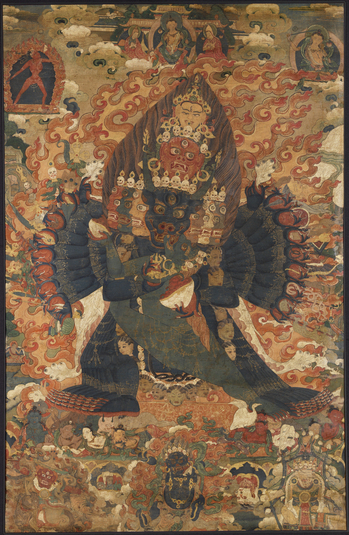
Item: Vajrabhairava (Buddhist Deity) - with consort
| Origin Location | Tibet |
|---|---|
| Date Range | 1700 - 1799 |
| Lineages | Gelug and Buddhist |
| Material | Ground Mineral Pigment on Cotton |
| Collection | Private |
Classification: Deity
Appearance: Animal-Feature
Gender: Male
Vajrabhairava (Tibetan: dor je jig je. English: Vajra Terror) with the consort Vajra Vetali.
At the top center is Maitreya flanked by Jowo Atisha and Je Tsongkapa. At the left side is Vajrayogini of the Naropa tradition, red in colour, in semi-peaceful appearance. On the right side is Arapachana Manjushri, orange in colour, holding upraised a sword of wisdom. At the bottom center is 'Inner' Yama Dharmaraja. At the right side is Nechung Chogyong. At the left side is Damchen Garwa Nagpo, red in colour, riding a goat.
Vajrabhairava is a wrathful form of Manjushri and functions as a meditational deity of the Anuttarayoga Classification in Tantric Buddhism. Vajrabhairava is NOT a protector deity and is NOT included in any Buddhist classifications of protectors. As a principal meditational deity Vajrabhairava, belongs to the Vajrabhairava and Yamari class of tantras and specifically arises from the Vajrabhairava Root Tantra (Tib.: jig je tsa gyu). The Vajrabhairava and Yamari Tantras belong to the method (father) classification of Anuttaryoga Tantra.
The practice of Vajrabhairava is common to the three main Sarma Schools of Tibetan Buddhism: Sakya, Kagyu and Gelug. Among the Sakya it is counted as one of the four main tantric deities along with Hevajra, Guhyasamaja and Chakrasamvara (Tib.: gyu de shi). Amongst the various Kagyu Schools the Drigungpa are strong upholders of the practice. In the Gelug School Vajrabhairava is the principal meditational deity taught for Anuttarayoga practice along with the meditational deities Akshobhyavajra Guhyasamaja and Chakrasamvara. There are numerous forms and styles of practice from the very complex with numerous deities to the very concise with a single Heruka form - one face and two arms. From amongst the many different lineages and teachings of Vajrabhairava to enter Tibet it is said that the main ones were those of Rwa Lotsawa and Mal Lotsawa.
Jeff Watt [8-1998]
Buddhist Deity: Vajrabhairava Main Page
Collection: Bonhams NY, March 2018
Collection: Sotheby's New York (Painting, March 2023)
Collection: Private XV (Painting)

